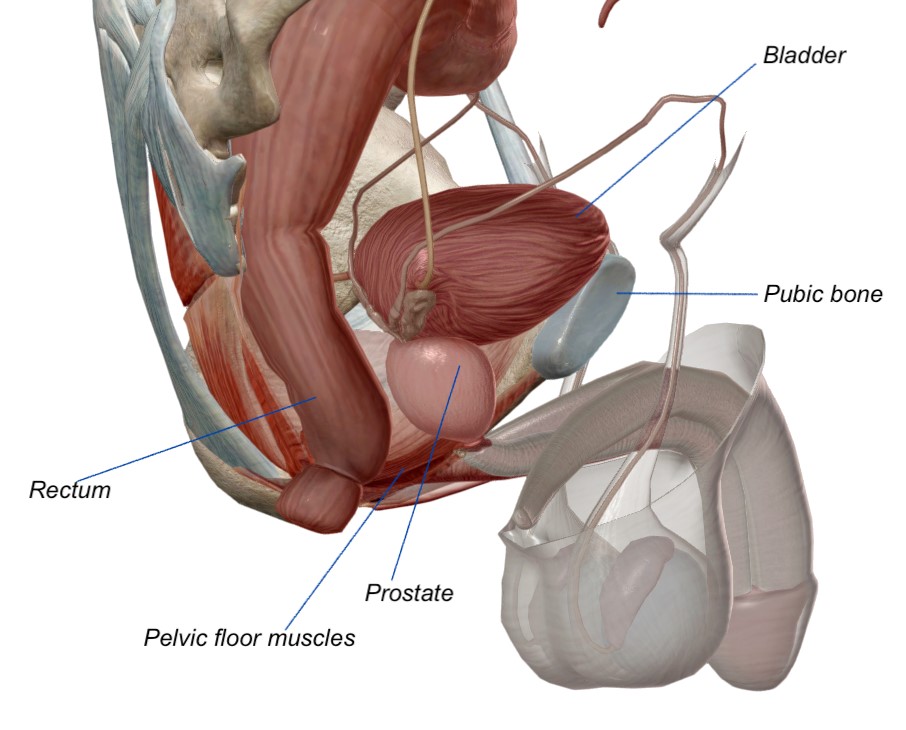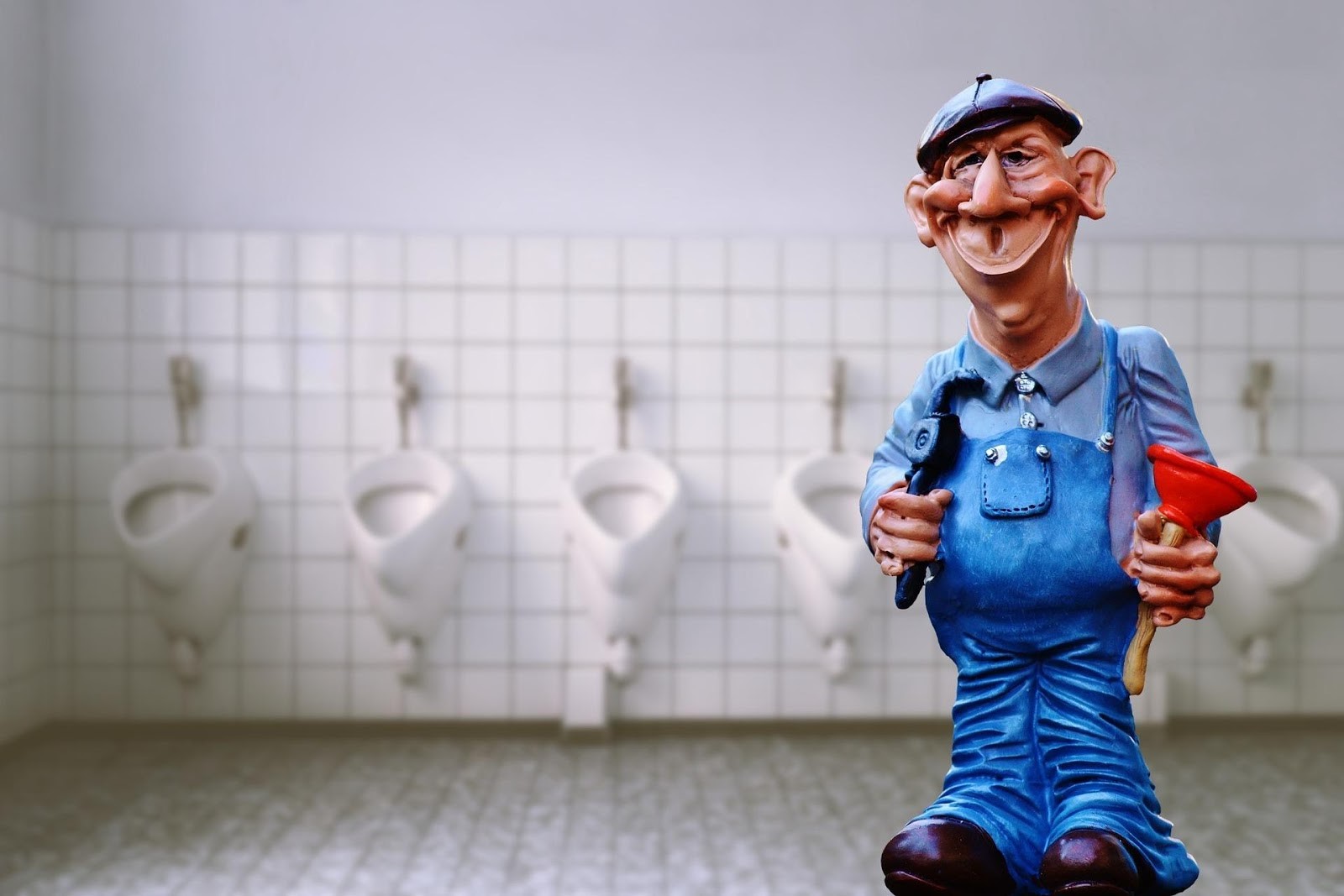You used to pride yourself on having a champion bladder. Now not so much.
Everywhere you go, you have to scan the place for a bathroom because that burning, pressure and ache in the pit of your belly just won’t go away until you relieve yourself. Phew! Until the next wave hits anyway.
Sounds to me like your bladder is running the show.
Urinary urgency and frequency is a complaint that often co-occurs with pelvic pain. Not always, but commonly enough to inspire me to write about it.
The more you know about how your body works, the better grip you’ll have on what’s happening. So, let’s start with a little anatomy lesson.
The bladder is a stretchy balloon that sits right behind your pubic bone. Its neighbors are the rectum, prostate, pelvic floor muscles, penis, intestines… In fact, pretty much everything in the surrounding area can influence the urinary subdivision.

So let’s say one of your neighbors’ alarms goes off in the middle of the night and keeps blaring until it wakes you up. Most likely, you’d flip on the lights and go see what the heck is going on next door, right?
The same goes for the communication between the pelvic floor and bladder. Neighbors can be nosey, so when one house on the block is acting weird, the others get curious.
It’s been said that there are over 45 miles of nerves in our body, communicating with our internal and external world. Whenever there is distress, you better believe these nerves are going to perk up and listen.
Pelvic pain is distressing and this causes the alarm bells to keep going off, which can make neighboring structures curious indeed, sometimes even joining in the commotion.
Urgency and frequency (and pain) that isn’t attributable to infection is most likely due to an overly sensitive nervous system [ref]. Even in the cases of diagnoses like interstitial cystitis (IC) or bladder pain syndrome (BPS), we’re discovering that the neuroimmune system plays an integral role. Many of the same symptoms overlap with those we see in pelvic pain, which is why diagnosis isn’t so easy and misdiagnosis common.
Pelvic pain symptoms overlapping with IC/BPS:
- Pressure or discomfort in the lower belly
- Urinary urgency and frequency
- Painful urination
- Peeing making it feel better
- Bladder spasms
- Bladder pain
These are umbrella symptoms that can fall under many categories and shouldn’t be treated with a “find it, fix it” approach. Like pelvic pain, urinary symptoms are multimodal and often co-occur with pelvic pain.
It’s important to note that diagnoses like IC or BPS are still poorly understood and the initial course of action should be the more conservative, less invasive treatments.
So, What Can You Do to Ease Your Plumbing Woes?
- Log your diet: You might find certain foods or drinks trigger or worsen your symptoms. If that’s the case, moderate these items or get rid of them entirely until things calm down. Once the alarm-bell volume is turned down, start to reintroduce these foods into your life slowly and in moderation giving your body enough time to adapt.
We still don’t know the exact mechanisms in play where diet impacts bladder and pelvic floor symptoms. Unique as a thumbprint, there’s a lot of variability around sensitivity based on the individual.
Some theories include [ref] [ref] [ref]:
- Changes in the bladder tissue itself altering the sensitivity response of substances/chemicals filtering through the bladder.
- Organ ‘cross-talk’ where stimuli and messages from one organ can lead to changes in another organ via the nervous and immune systems. These changes can occur at the tissue, spinal cord and brain levels. Often times, it’s a combination of all three.
- Nervous system up-regulation or sensitivity, which can happen in the brain, spinal cord or ‘danger’ sensors located in the tissues. This is also influenced by your immune system and can keep things ramped up or dampened down.
People with bladder issues will tend to limit their fluid intake thinking that it will make the urge and frequency of peeing go away. This is a myth, sorry guys.
Hydration will actually nourish your bladder, muscles, nerves, joints, oh just about everything. Your bladder is a muscle and the only way it will get some exercise is if it can stretch, fill and squeeze to empty. Limiting fluid intake often makes the sensitivity issue worse.
- Train your bladder: Log your toileting habits. Download this bladder log to help you track your habits and recognize patterns. If you notice yourself going to the bathroom every 30 minutes to an hour, you might want to consider re-training your bladder. Challenge yourself to increase the time between voids in 15-minute increments. Progress slowly to build up your tolerance.
Average bladder holding times can range from 3-4 hours. Sometimes even more when we’re distracted enough or when we’re sleeping. Your bladder can make it all night without going to the bathroom. (Okay, maybe you wake up once to pee, which is normal.) It’s pretty amazing that 7-8 hours can go by without an urge to go.
Remember that what you drink or eat can be a trigger so it would be helpful to set yourself up for success by moderating or eliminating those triggers during your training time.
Urge control tips and tricks: - When you feel the urge to go, don’t panic! Instead, focus on your breath to modulate the nervous system response and calm down the bladder.
- Gently engage the muscles around your penis as if you were trying to stop the flow of urine; in other words, lift your ‘nuts to your guts’. Don’t overdo it. Just engage your muscles slightly so you feel them, then let the contraction go while continuously breathing. Tighten and relax about 8-10 times. Repeat as needed during waves of intense urge.
- Distraction is your friend. Sing a song, phone a friend, stand on your head, whatever you want to do to take your mind off your bladder.
- Practice consistently. When was the last time you learned something new and mastered it right away?
- Let it go, let it flow: Breathe while you pee. I know it sounds simple, but when the tap isn’t flowing, it’s easy to get wrapped up in what’s wrong rather than what’s good.
Scientists have shown that what you think about your pain can change how you feel [ref] [ref]. Meaning your perspective on what’s happening in your body will influence your bodily functions. It can magnify or play down the sensitivity of your neuroimmune system. - So the next time you’re peeing, close your eyes, breathe deeply and focus on your breath. Allow the muscles of your belly, back and pelvic floor to soften and relax. This will help train your bladder and pelvic floor muscles to work synergistically with each other, improving communication and function, while lessening urinary and pelvic discomfort.
Be consistent with your practice. It takes time to reorganize and re-train the nervous system, so set yourself up for success by making the necessary lifestyle changes needed for positive outcomes.
If your DIY approach feels like you’re throwing darts with the blindfold on, we’ve got some work to do. Let’s chat to get you back on track.
Bladder image courtesy of Visible Body




